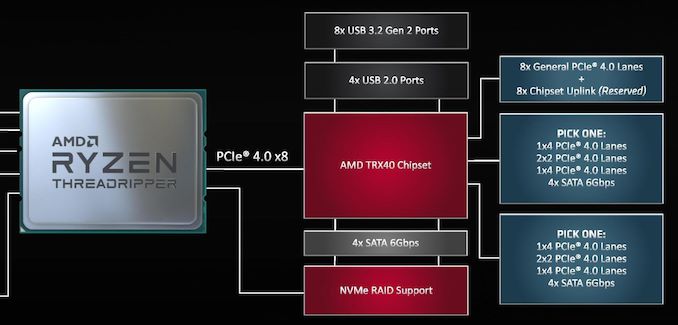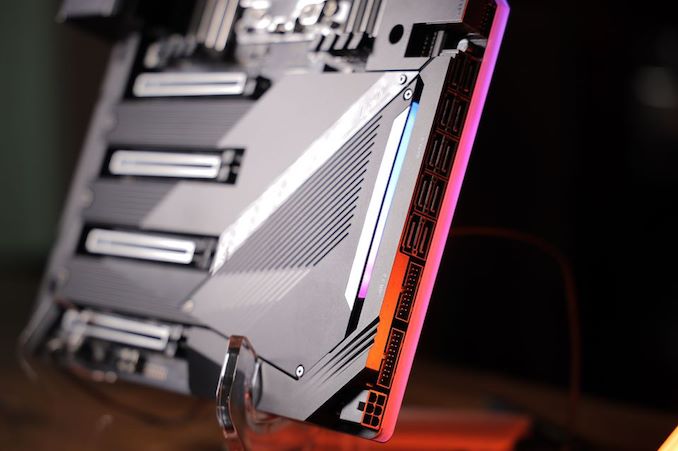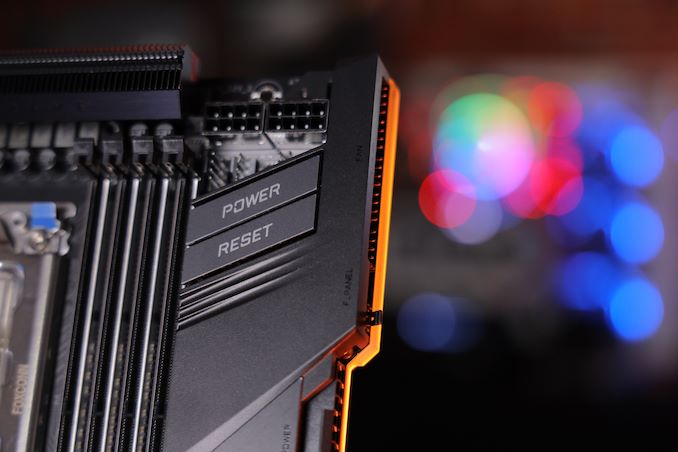AMD Q4: 16-core Ryzen 9 3950X, Threadripper Up To 32-Core 3970X, Coming November 25th
by Dr. Ian Cutress on November 7, 2019 9:00 AM ESTTRX40: More High-End Motherboards for TR3
The new sTRX4 socket will be paired with a TRX40 chipset – a design that AMD says comes from an in-house team and built on GlobalFoundries 14nm. The new chipset, updated from the previous X399 in this space and even updated from the X570 in the consumer space, is the other half in the CPU-to-chipset bandwidth story. By using a PCIe 4.0 x8 link, AMD is removing almost any practical bandwidth limitation downstream from the CPU.
The new TRX40 chipset will come with a degree of modularity.
From the chipset, we can see motherboard manufacturers afforded a full PCIe 4.0 x8 slot, up to another x8 lanes as two x4 connections or further bifurcated, or instead of those bifurcated lanes, either four or eight more SATA ports. That’s 8 SATA ports on top of the four already present on the chipset.
So I like these modular systems. It allows motherboard manufacturers to go crazy with offering potential systems. For example:
| Potential TRX40 Variants | |||||||
| AnandTech | CPU | Chipset | |||||
| TRX40 SATA Powerhouse 20 drives |
x48 for PCIe slots | x8 for downlink | 8x SATA from options | x8 for dual NVMe | 8x SATA from options | 4x SATA from chipset | |
| TRX40 NVMe Powerhouse 18+ drives |
x48 for PCIe slots | x8 for downlink | dual NVMe from options | x8 for dual NVMe | dual NVMe for options | - | |
So that would be a motherboard with x16/x16/x16 (or x16/x8/x16/x8) in terms of PCIe 4.0 slots, a single x8 slot for a pair of NVMe drives, and then TWENTY SATA ports, all directly supported on the system without any additional controllers.
If SATA isn’t your thing, then the same arguments could be made for 48 PCIe lanes and six PCIe 4.0 x4 NVMe slots, making a total of 18 high capacity PCIe 4.0 drives. The fact that AMD has put more PCIe lanes into their high end desktop platforms, plus this amount of modularity, wants me to play Dr. Frankenstein.
To be fair, those ideas are a bit extreme. Motherboard manufacturers will likely have to partition off a few lanes for 10 GbE networking, perhaps Thunderbolt, or maybe something more exotic like a RAID controller, or an RGB controller.
As noted in some of our previous news posts, motherboard manufacturers have been slowly leaking names of their TRX40 products. At this point in time we have seen mentions of the following:
- ASRock TRX40 Creator
- ASRock TRX40 Taichi
- GIGABYTE TRX40 AORUS XTREME
- ASUS Prime TRX40 Pro
- ASUS ROG Zenith II Extreme
- MSI TRX40 Creator
- MSI TRX40 Pro 10G
- MSI TRX40 Pro Wi-Fi
We expect details of some of these to perhaps be announced today, or on the 25th when the CPUs come to market. GIGABYTE has even been showing previews of their motherboards on social media, with one showing an obscene number of power phases, and we’ve seen images of boards with 8 SATA ports. We’ll have our usual motherboard overview article up on that date, and we’ll be looking at reviews of these motherboards through the new year.
I will address comments about potential TRX80/WRX80 motherboards which have been put into the ether as potential other chipsets being launched. When asked, AMD said that the only chipset they are launching today is TRX40.













171 Comments
View All Comments
evernessince - Thursday, November 7, 2019 - link
It's a HEDT processor, it's designed for professionals. If it speeds up your work then that for many is worth a lot of money.Irata - Friday, November 8, 2019 - link
That's why I said "considerable part of buyers". I am sure that for professionals it is more than worth it.For someone like me, however, it would definitely be a "want" CPU - as far as my needs / use cases go, a 3700x or even 3600 would be perfectly fine, however I want a 3950x because it is what it is.
The cool thing is that I can get a lower end Ryzen 3000 now (with a good main board) and upgrade to the 3950x later when it is offered at EOL prices.
Spunjji - Friday, November 8, 2019 - link
One thing I like about the 3950X is that it's blurring the lines of what HEDT is, in a good way. Availability of this many cores on a mainstream desktop platform is a great incentive for developers to look for ways to use that power.As Irata points out - your common-or-garden end user can purchase a 4, 6 or 8-core system and then eventually upgrade to 3950X at a (potentially much) later date when more software benefits. There's already been an uptick in software like games using meaningfully more cores since Zen first released; I'd anticipate that trend continuing, albeit acknowledging the difficulty of multi-core scaling for many tasks means the trend will likely slow down.
MASSAMKULABOX - Monday, November 11, 2019 - link
yep anything above 6 cores is gonna sit around doing nothing most of the time , for ordinary users. And ven for other users multi-cores are very under utilized... they have run out of ideas to make us upgrade, datacentres need it and HPC need it but home users? no way .. E-peen ?b.ritesManch - Thursday, November 7, 2019 - link
TR is mainly for content creation and other things where more cores is beneficial. If games and browsers are your thing, just get a Zen 3 or Intel equiv. No point in spending on this.haukionkannel - Friday, November 8, 2019 - link
Yep... 3600 or 3700 Are for Gaming. Anything above more to content creation!Targon - Thursday, November 7, 2019 - link
A game like Kingdom Come: Deliverance shows that performance can drag with a lower number of CPU cores, but I don't know how well it scales up. I would expect that similar games with a lot of AI controlled NPCs would see a big benefit from additional CPU cores if the game is designed to use them.SeannyB - Thursday, November 7, 2019 - link
TR 1950X user here. In general use, it's great at multitasking. You can be doing a lot of things at once and the system doesn't choke because there are always more cores. And the rare case (certain kinds of content creation) where a single program can utilize all cores, it's ludicrously faster than the 6-core Ivy Bridge "Extreme" I had prior. TR + fast storage + 32GB RAM is a dream machine for PC desktop, IMO.As far as gaming goes, benchmarks tell the story. Game engines that can multi-thread draw calls running content that is mostly limited by draw calls see the most benefit, but even then it won't beat a fast Intel; TR will keep pace at best. Off-the-shelf game engines like Unity & Unreal run all of their game logic & world/physics simulation on one or two threads, so simulation games using those engines like Cities Skylines and Kerbal Space Program are ultimately CPU frequency-limited because the bottleneck lies in their gamesim/physics thread.
surt - Thursday, November 7, 2019 - link
If you have reason to buy TR, you should really be buying no less than 64G to pair it with.SeannyB - Thursday, November 7, 2019 - link
In 2017, 64GB seemed like overkill for a 16-core system. Even now, I never top out even as I'm running Unreal Engine (editor), 3DS Max, Ableton Live even simultaneously... Of course, YMMV. 16-core soon enough will merely be a top-end Ryzen, and 24-core & up is a decidedly different class of computer, and I suppose 64GB is appropriate for that.